Abstract
The deposits of the Bazhenov formation are a unique reservoir of unconventional oil reserves in Western Siberia. They contain both solid organic matter (kerogen) and liquid light oil. The successful development of these hydrocarbons is largely determined by the adequacy of the void space models. The aim of the study is to identify the types of void space in the sediments of the Bazhenov formation and to identify the distribution patterns across the section of the researched wells. The void space was studied by electron and optical microscopy, and the mineral composition of the rocks was determined by X-ray diffraction analysis. The deposits of the Bazhenov productive formation in the territory of Western Siberia are represented by a wide complex of lithotypes, including various kinds of silicites, carbonate, clay rocks, and mixtites. The reservoir space in the reservoir rocks of the Bazhenov formation is a complex and hierarchically subordinated system, which includes voids and fractures of various sizes, configurations, and genesis. The void space of the Bazhenov formation is characterized by a fairly high degree of spatial heterogeneity, which is controlled by lithological, facies, and tectonic factors, as well as the direction of catagenetic processes.
1. Introduction
The Bazhenov formation (J3v) is a regional formation in Western Siberia and is considered as the most promising unconventional source of hydrocarbons in Russia.
The deposits of the Bazhenov formation are complex geological objects whose properties are determined by the mineral composition, structure, and degree of transformation of the rocks composing it, as well as the intensity of their tectonic disunity. The rocks composing the deposits of the Bazhenov formation are multicomponent. They are composed of siliceous, clay, carbonate, and organic components. Pyrite clusters play a significant role in the rock structure. The ratio of these components varies significantly both in area and section. Contrary to the prevailing opinion, the void space in the rocks of the Bazhenov formation has a wide variety of characteristics, which largely determines the spatial heterogeneity of this reservoir.
The study of the parameters of the heterogeneity of the void space is of great practical value when creating technologies for the development of hydrocarbons in the deposits of the Bazhenov formation.
A significant number of works have been devoted to the study of the void space of the Bazhenov formation. Almost all researchers assign the main role in the reservoir space of the Bazhenov formation to various kinds of fractures [1,2]. In the works of E. M. Hali mov, (1984) [3], E. M. Halimov, (1980) [4], K. I. Mikulenko (1974) [5], M. Yu. Zubkov (2001) [6], it is noted that the main components of the reservoir space are fractures, and only in the case of the presence of carbonate interlayers is the presence of cavities assumed. A significant number of works are devoted to the formation of voids due to the thermal degradation of organic matter, which occurs in the temperature range of 105 °C–120 °C [7]. Some studies have shown that a certain part of the void space in the Bazhenov formation was formed due to diagenetic and catagenetic processes that transformed the mineral matrix of rocks and organic matter [8,9]. In the works of foreign researchers, the issues related to the relationship of porosity with the mineral composition and the microstructure in high-carbon deposits have been considered [10,11,12,13,14].
Despite the considerable amount of research conducted to date on the void space in the Bazhenov formation, the problem of the ratio of the different types of voids and their role in the poreperm system of this reservoir remains relevant.
The objective of this work was to study and typify the void space in the Bazhenov formation, to identify the patterns of distribution of the types of void space in the section, and to determine the character of the relationship of all the selected types of voids and fractures in the hydrodynamic system of a reservoir.
To date, the results of the development of the resources in the Bazhenov formation reservoirs are very ambiguous. This may be due to the lack of filtration models that take into account the movement of fluids in various types of voids and fractures contained in the deposits of the Bazhenov formation. Identifying the types of void space and determining the patterns of their spatial distribution in the deposits of the Bazhenov formation is an important task.
2. Materials and Methods
Samples from well sections of the Yuzhno-Priobskaya, Yuzhnaya, Orekhovo-Ermakovskaya, Novogodnaya, and Yuzhno-Kinyaminskaya areas were studied by different kinds of methods (Table 1).

Table 1.
Explored areas and the number of samples examined (one sample includes a thin section, a sample for SEM research, and a fine powder for X-ray diffractometric studies).
Lithological typing was carried out mainly on macro-samples and thin sections of non-standard thickness, significantly less than 0.03 mm (about 0.01 mm). This made it possible to neutralize the distortion of the optical characteristics of minerals and the loss of microtexture resulting from a large amount of organic matter.
The mineral composition of the rocks was determined using X-ray diffractometric studies. Diffractometric analysis was conducted using the Rigaku SmartLab X-Ray Diffractometer, which is designed to study mineral and rock powders. The best results are achieved when using a powder with a particle size of 10 to 50 microns. For the gross analysis, the sample was crushed in a mechanical mortar, namely the Fritsch Pulverisette 2 with a tungsten carbide headset, chosen due to its high mechanical stability. During the preparation process, the powder was passed through a sieve of 100, 50, and 20 microns in size to obtain a more evenly grained material. Re-crushing was performed only for relatively large fractions. Undirected samples were made from the resulting powder. To achieve the most accurate results, the diffractometric survey was carried out at a speed of 5° per minute in the intervals from 5° to 90°. The percentage of minerals in the samples was calculated using the semi-quantitative RIR (Reference Intensity Ratio) method [15].
The study of the void space types was carried out on macro-samples using a stereoscope Carl Zeiss Micro Imaging GmbH, in thin sections using an optical polarization microscope Axio Imager A2m Carl Zeiss and mainly using a scanning electron microscope JSM 6610 LV, Jeol (Tokyo, Japan), equipped with an energy-dispersive spectrometer IE350 (OXFORD INSTRUMENTS, Oxford, UK). For electron microscopic studies, samples of 3–4 cm in size were extracted in a Soxlet apparatus with chemically pure chloroform for 48 h. Subsequently, the samples were subjected to vacuum freezing drying in the W113-DC800—Yamato Scientific apparatus (Tokyo, Japan) for 12 h. The prepared rock samples for viewing in the electron microscope were attached to the holder with an electrically conductive carbon tape and then, to remove the charge formed by the interaction of the electron beam with the sample surface, they were sprayed with a thin conductive platinum coating. The thickness of the platinum layer was 20 nm. The spraying was carried out in the JFC-1600, JEOL device (Tokyo, Japan). The samples were studied under the conditions of secondary electron and back scattered electrons. The main characteristics of the survey of the studied samples were accelerating voltage, 20–30 kV; spot size, 40–45; and working distance, 10–12 mm.
The diagnosis of the minerals by SEM was performed using an energy-dispersive spectrometer IE350 (OXFORD INSTRUMENTS, Oxford, UK).
The fracturing analysis was performed using the PathTracker software. It allows you to identify fracture intervals of various kinds based on photographs of core material in daylight and ultraviolet light, to measure the angles of inclination of fractures in the plane of the cut, and to record the length of both individual fractures and fracturing intervals.
The measured parameters were used to determine the fracture density and type of fractures, and to identify multidirectional systems of fractures. The obtained values were compared with the data on the filtration and reservoir properties of rocks, allowing us to estimate the contribution of fracturing to the formation of reservoir properties.
3. Results
3.1. Lithological Characteristics
Based on the study of the mineral composition, structure, and texture of the rocks of the Bazhenov formation, two main groups of lithotypes were identified using a set of methods (Figure 1) [16]:

Figure 1.
The main groups of lithotypes.
- with a predominance of one component (more than 50%);
- mixed rocks, where the content of the dominant component did not exceed 50%.
The first group of rocks was represented by siliceous, clay, and carbonate rocks.
The siliceous rocks were represented by silicides. Within them, a separate subgroup of radiolarites was distinguished.
In silicites, according to X-ray diffraction analysis, the amount of the siliceous component varied in the range of 55–65% (Figure 2). The structure of the siliceous substance was micro-fine-grained and the distribution in the rock was relatively uniform. In addition to the siliceous component, they contained clay matter and kerogen in approximately equal proportions. There were single inclusions of siltstone material.
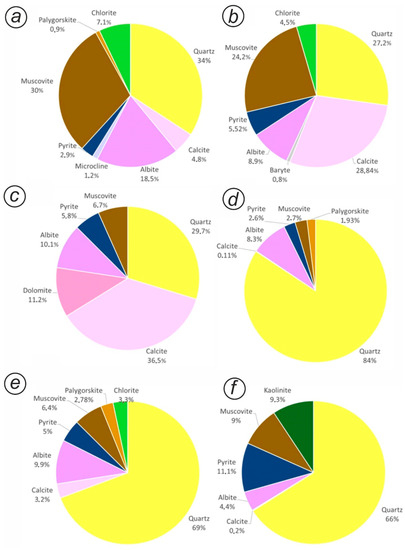
Figure 2.
Variations in the mineral composition of mixtites (top) and silicites (bottom) based on the results of diffractometric analysis. Samples: Novogodnyaya well (a), Yuzhnaya well (b), Yuzhno-Priobskaya well (c,d), Yuzhno-Kinyaminskaya well (e), Orehovo-Ermakovskaya (f).
Radiolarites were distinguished in a separate subgroup by the predominance in the structure of clearly diagnosed remnants of radiolarian shells made of chalcedony and cristobalite. In the subtype of carbonate radiolarites, the shells were replaced by a micro-fine-grained carbonate substance, and the clay impurity content was 25–35%.
The clay rocks were composed of a micro-fine-scaled clay substance with an admixture of siliceous. The clay flakes were oriented parallel to the stratification. The rocks contained a terrigenous detrital admixture of up to 10–12% in the form of quartz grains, feldspars of angular, semi-angular, semi-rolled forms, and mica (muscovite) flakes. In addition, lenses and round-shaped inclusions composed of micro-fine-grained siliceous matter were ubiquitous. The lenses were oriented along the stratification with an elongated side, probably inherited from the radiolariae developed by the relics. Pyrite was present in a thinly dispersed form, in the form of rounded and irregular lenticular inclusions, and their clusters were in the form of globules. The amount of Pyrite was up to 7%.
The carbonate rocks were represented by kerogen limestones and dolomites. The main mass of rocks was composed of radiolarian shells and their relics of a rounded, oval-elongated, cone-shaped shape. The size of the shells was 0.03–0.25 mm. Radiolarians have a different degree of safety from bad to good with a partially preserved internal structure. Radiolarians are cemented with micro-fine-grained calcite and dolomite with an admixture of clay, siliceous substances, and kerogen.
The second group was represented by mixed rocks (mixtites), where the content of the dominant component did not exceed 50%. The mixtites were divided into subgroups according to the ratio of the main components—siliceous, carbonate, clay, and kerogen.
The clay component often dominated up to 45–50% and had a micro-fine-scale structure. The particles of clay minerals were oriented by layering. According to X-ray diffraction analysis, the clay material was represented by illite and chlorite, and a small amount of palygorskite. The siliceous component reached 40% and had a micro-fine-grained structure. The carbonate component in the rock was present in the form of secondary carbonate in the rock matrix and in the radiolarians. The content can reach 30–40%. It was represented by calcite and dolomite.
Almost all the studied rock samples were characterized by high values of organic matter content, from 8 to 20% [17,18,19].
The distribution of organic matter in the rocks was very heterogeneous. The largest amount of matter was typical for mixtites, where it was distributed in layers. The smallest amount of matter was typical for radiolarites, where the organic matter was distributed in the form of randomly arranged spots.
3.2. Types of Void Space
The following types of void space were identified in the sediments of the Bazhenov formation:
- Voids up to 5 microns in size;
- Voids with an elongated shape, extending up to 100 microns;
- Large voids of 50–100 microns in size;
- Interform and intraform voids;
- Fractures with an opening of less than 0.02 mm;
- Fractures with a clear opening;
- Separation fractures;
- Fractures of shift have an oblique orientation;
- Closed, mineralized fractures.
3.2.1. Voids Up to 5 Microns in Size
The rocks of the Bazhenov formation have a complex structure of the void space, which combines pores, caverns, and fractures [20]. The voids are confined to the intergranular space and the surfaces of microfractures. The pore sizes varied from 1–2 to 400–450 microns.
The largest volume of void space was associated with voids up to 5 microns in size. Voids of this type were distributed fairly evenly in the rocks and created a cellular structure (Figure 3). They were widely represented in mixtites and silicites.
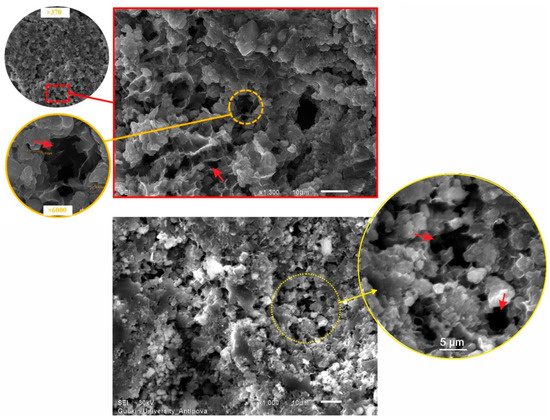
Figure 3.
Micro-voids with a cellular structure, 5–7 microns in size in clay silicite.
3.2.2. Voids with an Elongated Shape, Extending up to 100 Microns
The next group was represented by voids with an elongated shape, extending up to 100 microns with a predominant width of up to 5 microns (Figure 4). They were confined to thin-layered clay rocks and partially to mixtites. As a rule, this type of void was observed in the upper part of the section of the Bazhenov formation.
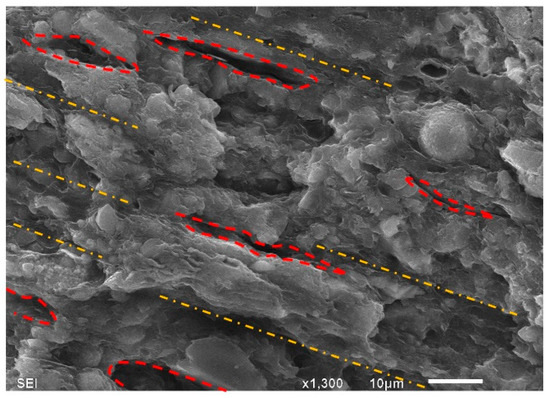
Figure 4.
Elongated voids with a size of 10–40 microns in clay rock.
3.2.3. Large Voids of 50–100 Microns in Size
In the middle part of the Bazhenov formation section, large voids of 50–100 microns were present in clay–kerogen silicites (Figure 5). On the surface of the walls of such voids, newly formed quartz crystals with a size of up to 5 microns, as well as flakes of kaolinite and illite with a size of 3–5 microns, were noted. These voids were often filled with organic matter, which was largely removed by chloroform extraction, which indicates its mobility.
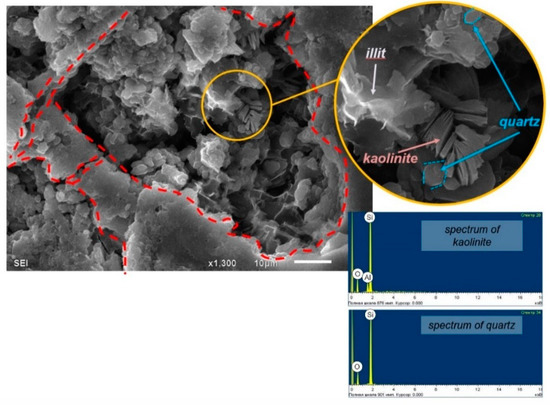
Figure 5.
Large voids of 60–80 microns are in clay–kerogen silicites. Quartz crystals up to 5 microns in size, as well as kaolinite and illite flakes of 3–5 microns in size on the surface of the walls of voids.
3.2.4. Interform and Intraform Voids
Interform and intraform voids were observed in the carbonate layers of the Bazhenov formation. Their size ranged from a few microns to 10–20 microns, and in some samples ranged from 400 to 500 microns. They were confined to the shells of pelecypods, radiolarians, and coccolithophorids (Figure 6). Moreover, in these rocks there were leaching voids, the size of which varied from a few micrometers to 70–100 microns.
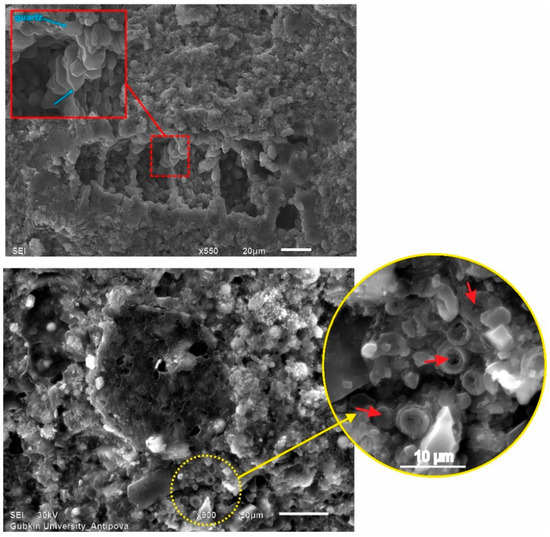
Figure 6.
Interform and intraform voids were confined to the shells of pelecypods, radiolarians, and coccolithophorids in the carbonate layers.
In the deposits of the Bazhenov formation, a large number of fractures of various types, spatial orientation, and prevalence have been found (Figure 7). The fractures are of tectonic, lithogenetic, and technogenic origin. Open and mineralized fractures are distinguished.
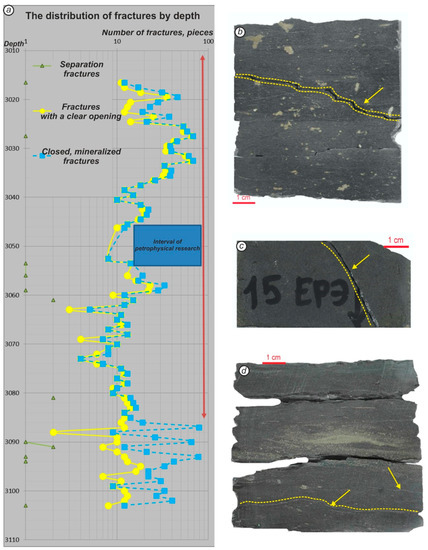
Figure 7.
The distribution of fracture by depth (a), fractures with a clear opening (b), separation fractures (c) and closed, mineralized fractures (d).
In the sections, both fractures with an opening of a fraction of mm and fractures with an opening of up to several mm were noted.
There are many techniques for analyzing fractures [21,22]. In this work, fracture assessment with the application of the program PathTracker was used as the method.
3.2.5. Fractures with an Opening of Less Than 0.02 mm
Visually observed fractures with an opening of less than 0.02 mm were identified. The nature of these fractures is hypothetical, and no reliable signs of their mineralization or oil saturation have been established. They have a subhorizontal orientation and were distributed sporadically in the section. The average number of such fractures in the Bazhenov formation was 1.75 pieces/m, in the underlying rocks—1.29 pieces/m. The maximum density value reached 24 pieces/m.
3.2.6. Fractures with a Clear Opening
Fractures with a clear opening were detected mainly in the oil-saturated part of the section. They were characterized by the presence of traces of hydrocarbons on the walls. The opening of fractures of this type was 0.02–0.2 mm. These fractures in the sections were distributed evenly and their orientation was mainly subhorizontal. The average number of fractures with an obvious opening in the Bazhenov formation was 14.5 pieces/m and in the underlying rocks it was 17.7 pieces/m. The maximum density value reached 123 pieces/m. The cracks were presumably of both lithogenetic and technogenic origin. The nature of these fractures was confirmed by the fact that they are associated with slit-like caverns formed during leaching and the partial mineralization of mollusk shells. Evidently, some of these fractures were primarily fractures with an opening of less than 0.02 mm, which significantly increased with the removal of the rock pressure or the various mechanical influences on the core.
3.2.7. Separation Fractures
Separation fractures were characterized by an inclined or vertical orientation. This type includes shapes that differ in orientation from the plane of deposition or from the horizontal more than 25–30°, in the absence of sliding mirrors. For the vast majority of these fractures, a tectonic nature was assumed, since mineralized fractures have a similar orientation. At the same time, it is impossible to completely exclude the technogenic nature of some of them. The average arithmetic content of such fractures in the section was less than 1 pieces/m. For this type of crack, the length varied from 5.66 to 84.98 pieces/m.
3.2.8. Fractures of Shift Have an Oblique Orientation
Fractures of shift had an oblique orientation. They were characterized by variable curvature on their walls, on which sliding mirrors were clearly expressed. However, the direction of the shear along the fractures was not revealed. Fractures of this type are of tectonic origin.
3.2.9. Closed, Mineralized Fractures
Closed, calcite-mineralized fractures are established mainly in carbonate rocks. The orientation of the fractures was similar to the separation fractures and the primary opening was 0.007–0.35 mm. As a result of mineralization, the fractures were completely filled with fine-grained calcite. The average number of closed (mineralized) fractures in the Bazhenov formation was 0.48 pieces/m and in the underlying rocks it was 7.64 pieces/m. The maximum density value reached 127 pieces/m.
Extended large fractures can connect oil-saturated areas with different types of porosity into a single hydrodynamic space. The analysis of the fracturing distribution over the Bazhenov formation section and the permeability values shows a fairly strong correlation in some cases (Figure 8).
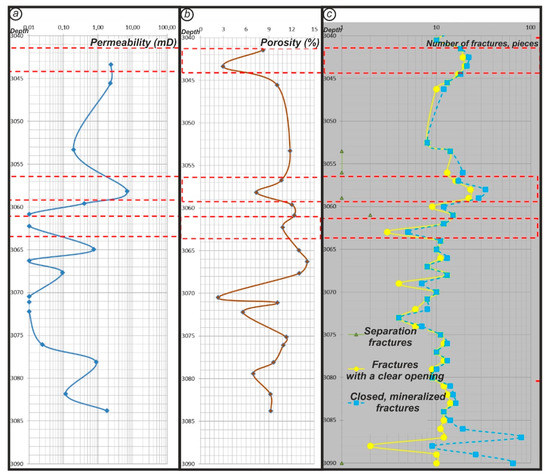
Figure 8.
Graph of the comparison of fracturing with petrophysical studies by depth. Yuzhno-Priobskaya well. Graphs of the distribution of permeability (a), porosity (b) and fractures (c) by depth.
4. Discussion
The variety of types of the void space of the Bazhenov formation revealed in this study, which includes small pores, various types of caverns up to 450 microns in size, and leaching voids confined to the fracture space, determines the hierarchy of the filtration and storage system of these deposits.
The most widespread type of void in the Bazhenov Formation deposits are small pores of less than 5 microns in size, which provide the main reservoir capacity.
It should be noted that the layer enriched with pelecipod shells, which stretches throughout the entire Yuzhno-Priobskoye field, is of particular importance in the section of the Bazhenov formation. This layer is associated with large slit-like voids, which are united in a single system by sub-horizontal fractures, the opening of which is provided by calcite crystals on their walls. This layer was found in the middle part of the Bazhenov formation section and the zone of increased permeability values is probably associated with it.
The upper part of the Bazhenov formation section, where clay rocks are widespread, is characterized by narrow slit-like voids, which are often filled with kerogen.
In the sections characterized by a relatively higher content of carbonate rocks, a significant role in the structure of the void space will be played by intra- and inter-shaped voids, as well as leaching voids.
In sections with a relatively higher content of carbonate rocks, intraform, and interform voids, as well as leaching voids, will play a significant role in the structure of the void space.
Horizontal fractures inherit the geometry of the void space. The distribution of the void space is controlled by the layered structure of the rocks of the Bazhenov formation. Moreover, the stratification surfaces are weakened zones along which fractures develop. However, there is also a system of vertical fractures. In general, the orthogonal system of fractures with the combination of different types of void space creates a hierarchical filtration-capacitance system, which should be the basis for fluid filtration models in the Bazhenov formation.
5. Conclusions
As a result of the conducted research, ideas about the microstructure of the void space have been detailed. It has been shown that elongated voids are confined to the upper part of the section, and isometric voids up to 5 microns in size are developed in the middle and lower parts of the section. The interlayers with high permeability, confined to the elongated pelecipod interlayers, were identified. An orthogonal system of fractures connecting voids of various sizes, shapes, and genesis into a single hydrodynamic system is substantiated.
Thus, the void space of the Bazhenov formation is characterized by a fairly high degree of spatial heterogeneity, which is controlled by lithological and tectonic factors, as well as the direction of catagenetic processes.
It should be noted that the natural structure of the filtration and storage space can significantly change during the development process as a result of the use of secondary methods of impact on the reservoir.
It will be necessary to conduct large-scale experimental work to study the results of the secondary impact on the rocks of the Bazhenov formation with different types of filtration and storage space.
Author Contributions
Conceptualization, O.V.P. and A.V.P.; methodology, A.V.P.; formal analysis, O.A.Z.; investigation, A.E.K., E.V.M. and L.A.S.; resources, O.V.P.; data curation, O.V.P.; writing—original draft preparation, A.V.P.; writing—review and editing, O.V.P. and O.A.Z.; visualization, O.A.Z.; supervision, A.V.P.; project administration, O.V.P. All authors have read and agreed to the published version of the manuscript.
Funding
This work was supported by the Ministry of Science and Higher Education of the Russian Federation under agreement No. 075-15-2020-936 dated 16 November 2020 within the framework of the development program for a world-class Research Center.
Data Availability Statement
The data presented in this study are openly available in article at 10.24887/0028-2448-2017-3-8-11, reference number [16].
Conflicts of Interest
The authors declare no conflict of interest. The funders had no role in the design of the study; in the collection, analyses, or interpretation of data; in the writing of the manuscript, or in the decision to publish the results.
References
- Gurari, F.G. Possible types of reservoirs associated with domanikites. Geol. Geophys. 1981, 12, 3–8. [Google Scholar]
- Gurari, F.G. Domanikites and their oil and gas content. Soviet Geol. 1981, 11, 3–12. [Google Scholar]
- Khalimov, E.M. Methodology for calculating oil reserves in the Bazhenov formation. Oil Ind. 1984, 6, 26–29. [Google Scholar]
- Khalimov, E.M.; Melik-Pashayev, V.S. On the search for industrial oil accumulations in the Bazhenov formation. Geol. Oil Gas 1980, 6, 1–10. [Google Scholar]
- Mikulenko, K.I. Prospects of oil and gas content of deposits of the Bazhenov formation in the central and southern regions of the West Siberian plate. Works Sib. Res. Inst. Geol. Geophys. Miner. Resour. 1974, 37–41. [Google Scholar]
- Zubkov, M.Y. Rocks of the Bazhenovo and Abalak Formations, Central Krasnoleninsk Arch, Western Siberia: Composition, Structure, and Formation Conditions. Lithol. Miner. Resour. 2001, 1, 37–48. [Google Scholar]
- Kirichek, A.V. Forecast of Fractured Reservoirs in Productive Rocks of the Krasnoleninsky Arch by Scattered Waves. Ph.D. Thesis, Industrial University of Tyumen, Tyumen, Russia, 2011. [Google Scholar]
- Beletskaya, S.N.; Bazhenova, T.K.; Klimova, L.I. Geochemistry of hydrocarbon migration processes in the Bazhenov formation of the Upper Jurassic of Western Siberia. Explor. Prot. Miner. Resour. 2010, No. 4, 54–58. [Google Scholar]
- Dorofeeva, T.V.; Krasnov, O.G.; Lebedev, B.A.; Petrova, G.V.; Pozinenko, B.V. Oil collectors of the Bazhenov formation of Western Siberia. Nedra 1983, 131. [Google Scholar]
- Fangwen, C.; Shuangfang, L.; Xue, D. Organoporosity Evaluation of Shale: A Case Study of the Lower Silurian Longmaxi Shale in Southeast Chongqing, China. Sci. World J. Vol. 2014. [Google Scholar] [CrossRef]
- Keller, L.M.; Holzer, L.; Wepf, R.; Gasser, P. 3D geometry and topology of pore pathways in Opalinus clay: Implications for mass transport. Appl. Clay Sci. 2011, 52, 85–95. [Google Scholar] [CrossRef]
- Holzer, L.; Cantoni, M. Review of FIB-Tomography; Utke, I., Moshkalev, S., Russell, P., Eds.; Nanofabrication with Focused Ion and Electron Beam: Principles and Applications; Oxford University Press: New York City, NY, USA, 2011; p. 830. [Google Scholar]
- Loucks, R.G.; Reed, R.M.; Ruppel, S.C.; Jarvie, D.M. Morphology, genesis, and distribution of nanometerscale pores in siliceous mudstones of the Missisipian Barnett Shale. J. Sediment. Res. 2009, 79, 848–861. [Google Scholar] [CrossRef] [Green Version]
- Loucks, R.G.; Reed, R.M.; Ruppel, S.C.; Hammes, U. Spectrum of pore types and networks in mudrocks and a descriptive classification for matrix-related mudrock pores. AAPG Bull. 2012, 96, 1071–1098. [Google Scholar] [CrossRef] [Green Version]
- Hubbard, C.R.; Snyder, R.L. RIR—Measurement and Use in Quantitative XRD. Powder Diffr. 1988, 3, 74–77. [Google Scholar] [CrossRef] [Green Version]
- Postnikov, A.V.; Gutman, I.S.; Postnikova, O.V.; Olenova, K.Y.; Khasanov, I.I.; Kuznetsov, A.S.; Potemkin, G.N. Different-scale investigations of geological heterogeneity of Bazhenov formation in terms of hydrocarbon potential evaluation. Oil Ind. 2017, 3, 8–11. [Google Scholar] [CrossRef]
- Vasiliev, A.L.; Pichkur, E.B.; Mikhutkin, A.A.; Spasennykh, M.Y.; Bogdanovich, N.N.; Belushkina, N.S.; Kalmykov, G.A. Studies of the morphology of the void space of the kerogen of the Bazhenov formation. Oil Ind. 2015, 10, 28–31. [Google Scholar]
- Nemova, V.D.; Matyukhina, T.A. Dependence of the organic matter content on the lithological types of rocks of the Bazhenov formation. Expo. Oil Gas 2018, 4, 23–26. [Google Scholar]
- Topchiy, M.S.; Pronina, N.V.; Kalmykov, A.G.; Kalmykov, G.A.; Fomina, M.M.; Karpov, Y.A.; Kozlova, E.V.; Fadeeva, N.P. Distribution of organic matter in rocks of the Bazhenov high-carbon formation. Bull. Mosc. Univ. Ser. 4 Geol. 2019, 2, 46–57. [Google Scholar] [CrossRef]
- Balushkina, N.S.; Kalmykov, G.A.; Korobova, N.I.; Shardanova, T.A. Structure of the void space of oil-saturated rocks of the Bazhenov and Abalak formations in the central part of the West Siberian basin. Bull. Mosc. Univ. Ser. 4 Geol. 2015, 5, 69–77. [Google Scholar]
- Milad, B.; Slatt, R. Impact of lithofacies variations and structural changes on natural fracture distributions. Interpretation 2018, 6, 873–887. [Google Scholar] [CrossRef]
- Milad, B.; Ghosh, S.; Suliman, M.; Slatt, R. Upscaled DFN models to understand the effects of natural fracture properties on fluid flow in the Hunton Group tight Limestone. In Proceedings of the Unconventional Resources Technology Conference, Houston, TX, USA, 23–25 July 2018; pp. 1193–1208. [Google Scholar]
Publisher’s Note: MDPI stays neutral with regard to jurisdictional claims in published maps and institutional affiliations. |
© 2021 by the authors. Licensee MDPI, Basel, Switzerland. This article is an open access article distributed under the terms and conditions of the Creative Commons Attribution (CC BY) license (https://creativecommons.org/licenses/by/4.0/).